
Website founded by
Milan Velimirović
in 2006
17:49 UTC


| |
MatPlus.Net  Forum Forum  General General  Construct a correct #2 with the most stalemate releases Construct a correct #2 with the most stalemate releases |
| |
|
|
|
|
You can only view this page!
| | Page: [Previous] [Next] 1 2 3 4 5 6 | | (1) Posted by James Malcom [Thursday, Nov 19, 2020 17:00] | Construct a correct #2 with the most stalemate releases
Today, I remembered Shinkmans classic "32" stalemate release.
William A. Shinkmanm, The Golden Argosy, #666 p. 286, 1929
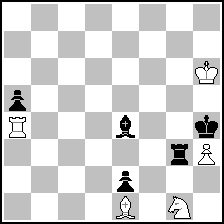 (= 5+5 ) (= 5+5 )
1. Bb4
And then I thought of applying this concept to the twomover. Furthermore, how many moves could Black be given in a correct form? I define two types-no dual mates allowed, a few allowed. No smorgasbords of mates please! I shall give what I have tried so far. Try and improve!
Moves given-14, A few duals mates
#2
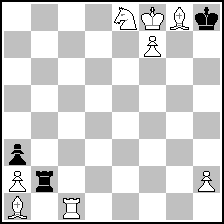 (= 8+3 ) (= 8+3 )
1. Rc3! ... 2. Rh3# (dual: Rb3# after Black plays Rb3, Rb7, & Rb8)
Moves Given-10, No Duals
#2
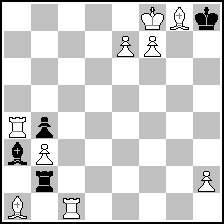 (= 9+4 ) (= 9+4 )
1. Rc3! ... 2. Rh3#
1... bxc3 2. Rh4#
But if you want a REAL challenge, construct one in which each given Black move results in a different mate-maximize White's amount of unique responses of course.
| | | (2) Posted by Hauke Reddmann [Thursday, Nov 19, 2020 19:43] |
Could swear it's in the Morse, but couldn't find it.
Ah, found it in the Albrecht: 80465 by Morse (who else).
(197.722 by Fink is the first rendering)
Ten variants by bR with ten different mates.
("Pattaufhebung" in the Albrecht gives 586 results,
"Pattaufhebung%Task" 18, many of which might be
interesting to your question!
| | | (3) Posted by James Malcom [Thursday, Nov 19, 2020 20:26] |
Albrecht? Link please!
| | | (4) Posted by Hauke Reddmann [Friday, Nov 20, 2020 08:57] |
Attention, German site, so the theme search feature
is in German too. Thus I also give the link to Hilmars
website: https://hilmar-alquiros.de
Add A.htm etc. for a multilingual lexicon.
Theme search:
http://www.schach-udo.de/albrecht/albrecht2/
Matrix search is possible too.
http://www.schach-udo.de/index4.php
| | | (5) Posted by James Malcom [Saturday, Nov 21, 2020 02:31] |
Thanks for all of those shenanigans. Hauke-I'll mess with 'em late on.
Incidentally, in the meantime, I've found a much higher number than either above, without any mates duals whatsoever along with great economy.
Moves Given-19, No Duals
#2
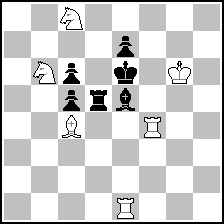 (= 6+6 ) (= 6+6 )
1. Be2! ... 2. Bg4#
| | | (6) Posted by Hauke Reddmann [Saturday, Nov 21, 2020 10:29] |
Indeed tricky, I'm already experimenting a quarter
of an hour, which is sluggish for me :-)
But you have to change Sb7->c8 or else 1...Td6 2.Sxc5.
| | | (7) Posted by James Malcom [Saturday, Nov 21, 2020 21:04] |
Whoops!-fixed.
The problem with giving the Black bishop more moves is that removing wRf4 allows 1... Rd4, and I can't find a way around it.
| | | (8) Posted by Jacques Rotenberg [Saturday, Nov 21, 2020 22:15] |
you can bring it to 20
| | | (9) Posted by James Malcom [Sunday, Nov 22, 2020 04:09] |
Jacques, I'm not seeing 20 as possible. How is it so?! Shifting the board to allow for a Black pawn's double step merely produces another 19, but in a ridiculous setting. Obviously, trying out pawn promotion won't work due to space constraints. Another limiting factor is that the Black rook must be protected by a pawn in order to throughly open up the board.
#2
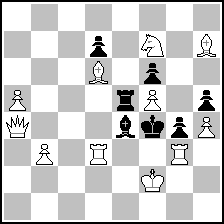 (= 11+7 ) (= 11+7 )
1. Bb4! ... 2. Bd2#
| | | (10) Posted by Jacques Rotenberg [Sunday, Nov 22, 2020 04:30] |
you are not far...
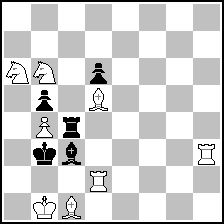 (= 8+5 ) (= 8+5 )
a wPa3 is possible instead of the Sa6, but here 1.Rb2+ Ka3 is more funny
| | | (11) Posted by James Malcom [Sunday, Nov 22, 2020 05:26] |
Well done, Jacque! Co-creation, may I presume? And I agree that the try 1. Rb2+? is very hilarious indeed!
| | | (12) Posted by Andrew Buchanan [Sunday, Nov 22, 2020 07:40] |
That's very nice, and I can't do better. 1.Rb2+? is one of the tries in either case, unless I've misunderstood. It's certainly necessary to eliminate what would be otherwise a cook. But the only difference between Pa3/Sa6 versions is whether the response 1...Ka3!/Kxa3! is a capture or not. This kind of fine distinction is non-thematic and is not on my general artistic radar, so I personally would rather have Pa3 than Sa6 on simple material economy grounds. The only difference in tries is 1.Ba3? vs 1.Sb8,Sc7? none of which are interesting. However if I am missing the joke, please explain :-) Congratulations anyway on this lovely construction.
| | | (13) Posted by Joost de Heer [Sunday, Nov 22, 2020 09:13] |
QUOTE
Albrecht? Link please!
Although Hauke already gave the link, you should check out https://www.wfcc.ch/software/ where several composition databases (and programs) are mentioned, including the Albrecht collection.
| | | (14) Posted by Hauke Reddmann [Sunday, Nov 22, 2020 09:44] |
BTW, you can have a matrix (with the R making the move, and
zugzwang) with even 21 moves, but its hopelessly cooked.
(I went to bed in the morning yesterday, so don't try :-)
Hauke
| | | (15) Posted by Jacques Rotenberg [Sunday, Nov 22, 2020 11:07] |
@ James
Thank you for your proposal, of course, you can also choose to sign alone, what I did here is very marginal, the idea and the matrix are yours
@Andrew
These kind of questions (pa3/Sa6) may seem very secondary and of no importance - and it would be right!
Anyhow, because such choices a composer have to make are very frequent it is worth giving some more explanations about the way I understand things, it is not really a waste of time, I hope.
1- The interception on b2 is nicer (more discreet) if a3 is empty
2- After 1.Rb2+ Ka3 the battery Bc1-Rb2 seems powerful, with the knight a6, the pawn b4 stops the rook from b4 and beyond, with a pawn a3 it would stop the rook only from b5, also the moves 2.Rb~2+ don't give mate because of b3, with a pawn a3 it would be because b3 and b4
3- Also the Sa6 gives the pawn d6 one more function : the guard of c5 1.Bf3! Rxb4 no dual
4-The possibility you mention 1.Ba3? Kxa3! is not so empty : it uses (like 1.Rb2+ Ka3) the unpinning of the rook c4
5- All that comes in a context of a very poor play (one threat, no variation) with heavy plugs like Rd2
So all these are very very small details, anyhow, for me it's enough to give my preference to the knight a6
| | | (16) Posted by Andrew Buchanan [Sunday, Nov 22, 2020 12:07] |
@Jacques
Thanks for your reply. I basically agree we composers must make numerous tiny decisions. If the position is very loose, then hopefully it's loose enough to suggest and accommodate substantive extra content. Other times we are lucky and the basic content determines the position exactly - that's like chipping a golf ball onto the the green, and it goes directly in the hole. However more often we're in the middle: the position is not entirely determined, but there's not enough looseness to add any real content. This is like the golf ball landing on the green, but we still need a putt or two to get it in the hole.
This does give scope for a composer to show individual flair, so we should expect philosophies to differ. Essentially, there seem to be two extremes to the approaches. One is to embed the absolute maximum of complexity, so that every piece is working absolutely as hard as it can. This was my style when I started to compose. I thought it was the only obvious approach. For example, in a proof game, if wPa moved once, I would stick it on a4 rather than a3, so there was the extra thinking required to determine if the pawn had spent two hops to get there. However, another composer explained that this was not the only way to view things. There is the notion of conceptual clarity: does the core message of the composition get carried across with the minimum of distraction? Clearly there is a grey area between these extremes, but I think I am these days closer to the second, and I don't want to include ornamental embellishes unless they really seem to pay their way.
To indicate I am not wedded to this approach, in a recent and hitherto unpublished problem I composed with Guus Rol, we discovered a mild difference of opinion. I argued for a complicating embellishment, however it's not the quickest way to reach soundness. After some civilized debate, we realized that the source of our disagreement was in our undiscussed ideas of the intended audience. He thought that the audience would be less sophisticated than I had in mind. So we agreed where to publish, and the resolution was then clear: to include the flourish.
On this occasion I see and respect your observations. But to me, the presence of wSa6 would promise more than it delivers, and I mildly prefer the lighter picture the diagram gives with wPa3. If wSa6 made the difference between 1.Rb2+? being a try or not, I might include it, but for secondary stuffs following 1.Rb2+?, I am unconvinced.
Anyway I've written too many words here about something very very minor. Thanks for responding, Jacques, no reason why we should expect to agree! :D Congratulations once again to both of you on a marvellous, harmonious, humorous composition.
| | | (17) Posted by Neal Turner [Sunday, Nov 22, 2020 16:11] |
@Andrew
Not minor at all - it goes to the very essence of what we do!
Are we in 'angels dancing on the head of a pin' territory?
Maybe, but who cares? It's fun!
| | | (18) Posted by Hauke Reddmann [Sunday, Nov 22, 2020 16:22] |
Seconded. As a composer, you should pay attention to detail.
(I construct anything that is constructible at all in
five minutes, the rest is polishment. :-)
| | | (19) Posted by James Malcom [Sunday, Nov 22, 2020 18:35] |
Jacques, as humble as you may be, I still consider a modest enough improvement: https://pdb.dieschwalbe.de/P1382303
(-:
And wonderful nitpicking Hauke, Neal, Andrew and the gang! It is indeed what we live for, the beauty, the arguements, the aesthetics, the reconciliation!
| | | (20) Posted by James Malcom [Sunday, Nov 22, 2020 19:56] |
Additionally, for the second challenge of different White mates, at least 4 is possible.
#2
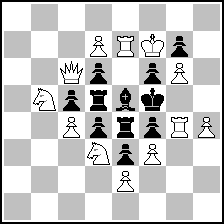 (= 12+11 ) (= 12+11 )
1. Rxe5+!
| |
Read more... | Page: [Previous] [Next] 1 2 3 4 5 6
MatPlus.Net  Forum Forum  General General  Construct a correct #2 with the most stalemate releases Construct a correct #2 with the most stalemate releases |
|
|
|
 ISC 2024
ISC 2024 Forum
Forum  General
General  Construct a correct #2 with the most stalemate releases
Construct a correct #2 with the most stalemate releases 


